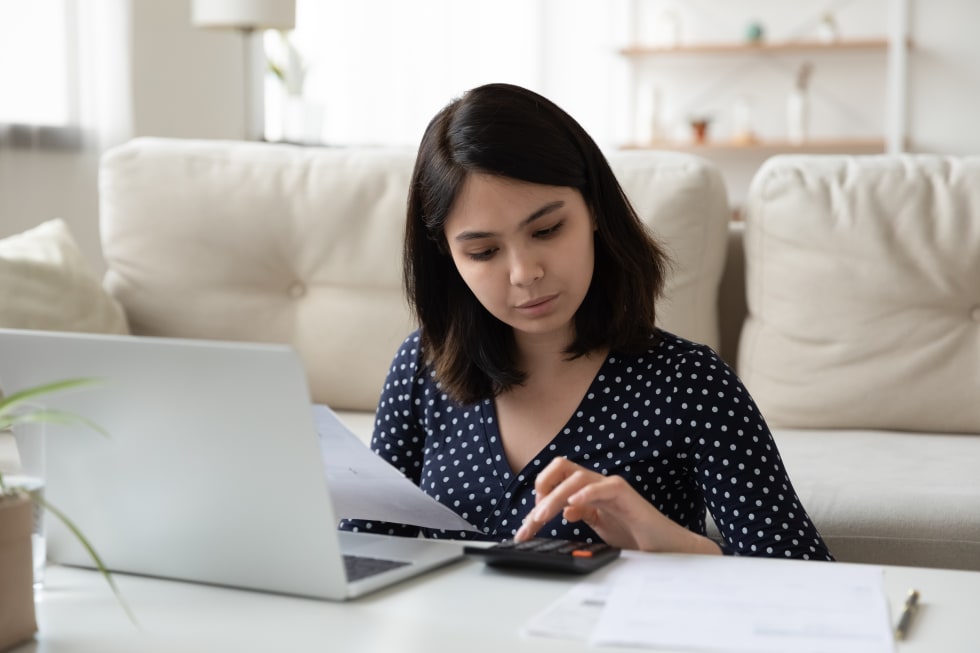How to Budget for Your First Apartment (Checklist and Tips)

If you are a first-time renter, knowing how to budget for an apartment is crucial. Prepare by following our first apartment budget checklist to help you stay on top of your finances.
How to Budget for an Apartment
There’s more to factor into your financial plans than just renting expenses. Here are some of the costs to consider when you’re budgeting for an apartment.
1. Moving Expenses
Moving is a one-time expense, but it’s still an essential part of your apartment budget. If you plan to move cross-country, you will likely need to invest in professional movers. You can also use movers locally, but even if you choose not to, you’ll probably still need to buy boxes and packing materials.
On average, it costs anywhere from $350 to $1,500 to hire movers for a one-bedroom apartment. For a four-bedroom home, it costs anywhere from $1,000 to $2,000. These rates are determined by the number of hours of labor it takes to complete the move. For long-distance moves, it costs anywhere between $900 to $6,000, depending on the distance of the move and how much stuff you’re moving. And don’t forget to tip your movers!
For a breakdown of expected costs for moving, check out our moving cost guide here.
2. Furniture
Even if you’re moving with furniture, you’ll likely need some extra pieces for your new place. The bare basics should include a bed, couch, kitchen table, and dresser. However, your budget for renting might include costs for storage, extra seating, decor, and a small office space to make your apartment more livable.
Sometimes it’s easier and cheaper to ditch old furniture, donate it, or sell it online. Take a look at what it would cost to buy new furniture against the costs of hiring movers to pack everything up for you. If you have nothing to move with but clothes and a few keepsakes, you can find cheap furniture options from outlet stores, secondhand shops, and Ikea.

3. Rent
Rent takes up a large portion of your take-home pay, so make sure you know how much you can afford to spend on rent. Average rent costs vary based on the city, state, and even the season. It’s typically cheaper to rent during the off-season, which is often in the winter months. But if you live in a neighborhood near a college or university, you may find the off-season is during the summer when students move home for a few months.
To give you an idea of what to expect, we listed a few popular cities (Austin, Boston, Chicago, Los Angeles, New York, Philadelphia, San Francisco, and Seattle) and their rent prices for a one-bedroom versus a two-bedroom.
| City | Average 1-Bedroom Rent | Average 2-Bedroom Rent |
|---|---|---|
| Austin, TX | $1,500 | $1,826 |
| Boston, MA | $3,193 | $3,702 |
| Chicago, IL | $1,308 | $1,420 |
| Los Angeles, CA | $1,670 | $2,205 |
| New York, NY | $2,059 | $2,174 |
| Philadelphia, PA | $1,126 | $1,311 |
| San Francisco, CA | $3,387 | $4,536 |
| Seattle, WA | $1,651 | $1,995 |
Of course, rents are still rising and stabilizing after the pandemic and housing industry shifts. Things change quickly, so check back with our latest national rent report to find average costs in your city.
Making your monthly rent payments on time is critical. It helps you stay on good terms with your landlord, avoid late payments, and increase your chances of being offered another lease when the terms expire. A short-term lease or month-to-month rental is also an option, but the monthly rent is usually higher because the landlord assumes more financial risk renting to a short-term renter. You’re paying for the flexibility and convenience.

Finding Cheap Apartments
A city’s average rent fluctuates, but there’s often some opportunity to pay a discounted rate or find move-in specials. Common specials include waived application fees or a free month's rent, which is spread out evenly over the duration of your lease.
When you take our quiz to get matched with an apartment, we'll ask you about your rental budget, and offer you tips and suggestions about flexing locations and amenities to keep you in your budget.
4. Utilities
Some apartments include partial utilities in the lease, which can save on your budget. But it’s the norm for renters to pay expenses related to electricity, heat, and natural gas. It’s wise to call your local utility providers to get your utilities set up under your name. Otherwise, you could face some delays.
Get an idea of your basic utilities with our breakdown below. These costs reflect electricity, heating, and cooling for a 915-square-foot apartment.
| City | Average Utilities Cost |
|---|---|
| Austin, TX | $236.71 |
| Boston, MA | $296.22 |
| Chicago, IL | $235.02 |
| Los Angeles, CA | $219.05 |
| New York, NY | $273.04 |
| Philadelphia, PA | $275.13 |
| San Francisco, CA | $239.48 |
| Seattle, WA | $233.54 |
If you are moving to a new city, do some research on the average cost of utilities in the area.
Remember, your utilities can fluctuate dramatically if you live in an area with extreme weather, like Arizona or Vermont. You should factor in some breathing room in your budget for renting for unexpected spikes during a heat wave or snowstorm. You can also save on your heating and gas bills with these tips for lowering your utility bill in winter.
Finally, double-check if there are any other utilities you need to cover before you move in. Some places require a fee for apartment complex amenities or trash and water. Trash rates are determined at the city or county level, so prices vary depending on your area.
Cable/Internet
The average monthly cable bill starts between $45 and $145 but can be even lower, depending on your area and introductory offer. Add-ons can cost up to $100 for extra channels and packages.
According to NerdWallet, the average monthly internet bill starts between $47 and $69 for 50 Mbps. You can save on your Wi-Fi costs by bundling your internet service with your cable or cell phone service.

Streaming Services (Netflix, Hulu, Max, Etc.)
Streaming services are oh-so-popular these days, and paying for a streaming service over cable can help you save money in the long run. Just don't forget to factor these costs into your monthly budget.
Streaming services range in price, but they each tend to cost under $15 a month:
- Netflix: $6.99 to $19.99 (or more with add-ons)
- Disney+: $7.99 to $19.99 (with Hulu and ESPN+ in a bundle)
- Hulu: $7.99 to $14.99 (or more with add-ons)
- Apple TV+: $6.99
- Max: $10 to $20
Phone Bill
Whether it is your cell phone or a landline, you have to pay to use your phone every month. Currently, the average cell phone bill sits at $45 per line to $140 for four lines. Rates vary, and you can lower your expenses by purchasing a basic plan and relying on Wi-Fi calling.
Other Subscriptions
Check your bank and credit card statements to look over all your subscriptions, from streaming media to magazines to wine clubs. Once you’ve made a list of all your subscriptions, check your quarterly expenses. Monthly subscription services can quickly increase your apartment expenses without your noticing.
5. Car Payments and Car Loans
Car payments, auto leases, and auto insurance add to your monthly budget. You should also consider fluctuating gas prices to determine how far you can commute without a negative impact on your budget. If you’re moving to a city with solid public transportation, you may be able to ditch the car and save more.
Parking and Transportation
Some apartments offer free parking, and some require you to pay for a dedicated spot. Depending on where you work, office parking may also come at a premium. Factor in all your parking costs, including for nightlife and recreation.
If you're not driving everywhere, are you taking the bus to work every day or commuting via train? Perhaps you ride city bikes on a regular basis. Public transportation may be cheaper than owning or using your car, but it still costs money, so factor this into your monthly spending.
6. Groceries and Food
Food is also a significant budget expense, whether you eat at home or enjoy dining and pub crawls. Think about how often you plan to grocery shop versus eat out, and factor in your monthly food costs. To give you an idea of what to expect, we collected some data on the average costs for an inexpensive meal in different cities.
| City | Average Meal Cost |
|---|---|
| Austin, TX | $16 |
| Boston, MA | $16 |
| Chicago, IL | $20 |
| Los Angeles, CA | $20 |
| New York, NY | $25 |
| Philadelphia, PA | $19 |
| San Francisco, CA | $21 |
| Seattle, WA | $20 |
7. Other Personal Payments
Besides utilities, you may have a number of other personal payments. You may not have all of these expenses.
Credit Card Payments
Many renters don’t account for ongoing credit card payments and any extra interest. Paying off your credit card is a critical component to building up a good credit score, which can also impact whether you can rent an apartment and secure loans later in life. As a rule of thumb, renters should only use their credit cards as a means to increase their credit score and establish a credit history or in the event of an emergency.

Student Loan Payments
If you’re renting your first apartment, you may have recently graduated from college with loans in tow. As the average student loan debt rose to an astounding $33,900 per individual in 2022, your monthly payments are likely to command a large percentage of your budget. Fortunately, student loan forgiveness is starting to become more common, especially if you work in a public sector job or other qualifying careers.
Health Insurance
Depending on your job, you may or may not have health insurance. Self-employed professionals and contractors usually secure health insurance through the Affordable Care Act. As of 2021, single employees pay an average of $1,643 annually toward their health insurance premiums, which translates to $136.92 monthly. However, these costs vary greatly depending on your health history, location, plan type, and more.
Gym Membership
If you love to work out, you can save on a gym membership by finding an apartment complex with an on-site fitness center. But if you need a good spin class or a more robust setup, you’ll need to budget for a membership. We put together the cost of gym memberships by city below.
| City | Average Gym Membership |
|---|---|
| Austin, TX | $49.52 |
| Boston, MA | $62.19 |
| Chicago, IL | $55.83 |
| Los Angeles, CA | $44.25 |
| New York, NY | $102.62 |
| Philadelphia, PA | $44.17 |
| San Francisco, CA | $100 |
| Seattle, WA | $55 |
If you decide a gym membership is too expensive while paying for your first apartment, check out our tips for setting up a home gym.
8. Renters Insurance
While not mandatory for most rentals, paying for renters insurance is a good idea. Most renters can find solid coverage for under $14 per month. You’ll appreciate the protection in case of an emergency, be it theft or an accident.
9. Entertainment
You also need a fun budget to enjoy your lifestyle. Take a look at your spending habits and figure out how much money you need to set aside in order to entertain yourself with movies, dinners, outings, and other activities. To give you an idea of what you’re looking at, here’s how much you should expect to spend at a movie theater in the following cities.
| City | Average Movie Ticket |
|---|---|
| Austin, TX | $12.75 |
| Boston, MA | $15 |
| Chicago, IL | $15 |
| Los Angeles, CA | $15.99 |
| New York, NY | $18 |
| Philadelphia, PA | $14 |
| San Francisco, CA | $16 |
| Seattle, WA | $15 |
What is the 50/30/20 Rule?
The 50/30/20 rule advises budgeters to set aside 50% of their post-tax income for needs, 30% for wants, and 20% for savings. Needs are pretty easy to identify and relate to your necessary bills, food, and housing costs.
Once you’ve set aside cash for essentials, you’re safe to use up to 30% of your income for your wants. Getting drinks with friends after work, splurging on multiple subscription services, and treating yourself to a new computer all fall under the 30% category. The last step is setting aside at least 20% of your post-tax income for savings, but the more, the better.

First Apartment Budget Tips
Knowing what to budget for is just the first step. But knowing how to budget is equally important. Here are some of our top tips on how to budget for an apartment.
1. Download Your Bank’s Mobile App
It’s important to have immediate access to your bank accounts so you know exactly how much money you have in your checking and savings accounts. If you have a credit card with the bank, you can check your spending and credit limit as well.
With the ability to constantly check your balance, you’ll always know whether you can splurge on that $60 pillow from Urban Outfitters or if you should look for your bedding decor at a store like Target.
You can download some of the popular banking apps for iPhone using the below links.
You can download some of the popular banking apps for Android using the below links.
2. Use a Spreadsheet
One of the most basic yet effective ways to keep a budget is to write it all down on paper. You’ll get a clear understanding of your needs versus your wants and what you can spend in different categories.
A spreadsheet is particularly helpful when figuring out how to budget for an apartment. Many additional expenses pop up that you may not think about when financially planning for your new place. A budget spreadsheet gives you a way to see how all your money is moving in one simplified place.
3. Use a Budgeting App
If writing down everything you spend is too tedious, there are budgeting apps to simplify the process. Apps like Mint and Qapital help keep track of your spending by connecting to your bank account and credit cards and organizing monthly expenses into spending categories like bills, entertainment, groceries, travel, and rainy day fund.
Your apps will often show real-time updates and send alerts if you’ve overspent. A caveat of using an app over a spreadsheet is that sometimes the apps don’t properly categorize certain purchases. However, you can always go in and categorize expenses as needed.
4. Review Your Renting Budget
The only way a budget works is if you keep on top of it and review everything. It’s easy to miss a few bills increasing or allow your 30% spending to balloon to 50%. Fortunately, it’s pretty easy to review your budget with the plethora of apps on the market, advanced banking tools, and paperless statements for on-the-go reviewal. You can also take stock of your expenses and make informed choices regarding where you can afford to cut costs.
5. Build an Emergency Fund
Make an emergency fund part of your budget. Your fund should include at least three months’ worth of living expenses. If you get laid off or face a medical emergency, you’ll have a safety net to fall back on. But don’t worry; you don’t have to hit your emergency fund goals all at once. Start with a one-month buffer and slowly work your way up to a three-month fund.
Another option is to follow an “envelope” savings approach. Whether you’re setting up an electronic fund or literally putting money in envelopes, the concept is the same. Put aside some money every paycheck to cover car and home repairs, clothing, and other major expenses that could cause a significant financial issue if you aren’t prepared for it.
6. Consider Renting With a Roommate
Renting with a roommate is one of the easiest ways to slash costs from your rent and utilities. Make sure to ask your roommates this checklist of questions to get on the same page about what to expect out of living together. For example, if you enjoy privacy, you’ll want to know how often your roommate’s significant other will stay over.
If you do team up with a roommate, they’ll also need to be on the lease and have a solid credit report. It’s important to only choose roommates who are financially responsible, or you could be paying for their mistakes if they can’t make rent.
7. Check Average Utility Costs
Utilities can quickly add hundreds of dollars to your monthly bills. Get a sense of the average utility costs and look for apartments with partially included utilities, which is usually water and heat. It’s also important to account for spikes in summer or winter if you live in an area that’s known for extreme seasonal weather.
Ask friends in similarly sized apartments about their utility bills. They may also have some tips and tricks to reduce your bills or help you find a deal with a specific utility provider.
8. Shop Around for Internet and Cable
Internet and cable are not considered part of traditional utilities as it’s technically something you could live without. But you can also shop around for a bundled Wi-Fi and cable package to save money. Or slash the cable altogether and use the internet to stream videos online.
If you already have unlimited data on your phone, explore whether you can turn it into a hot spot. You may be able to connect your laptop or smart TV directly to your phone’s coverage to fuel all the devices in your apartment.
9. Take Advantage of Fixed Monthly Rate Utility Plans
Usually, you pay utilities based on what you use that month. Increasingly, though, many utilities companies offer you a payment arrangement for a flat monthly rate. They company will look at the history of energy usage in your apartment and then use that to determine an average monthly rate. This helps you avoid large sparks during the height of winter or summer, when energy costs can be high. Keep in mind that if your usage exceeds their estimates, you may have to pay the surplus when you stop your plan.
You can also make the most of your utilities by practicing energy efficiency. Try swapping out lightbulbs, weather-stripping your windows, and reducing how often you use your lights and devices to further lower your energy consumption.
Make Your Move: Start Apartment Hunting with Apartment List
Figuring out how to budget for your first apartment doesn’t need to be overwhelming. With the right process and questions in hand, you can anticipate your monthly expenses and have breathing room for some fun. It’s also wise to leave some wiggle room for emergencies and unexpected expenses.
Ready to find a new place that fits into your budget? Sign up with Apartment List and use our filters to find apartments that fit into your budget. With us, you’ll spend 5 minutes and save 50 hours searching.
First Apartment Budget FAQs
How Much Should You Budget for a First Apartment?
Try not to spend more than one third of your income on rent. If you follow the 50/30/20 rule, then half of your budget should be spent on necessities, including rent as well as utilities, other bills, and groceries.
Take our quiz to set a budget, list the amenities you want, and specify your location. If the apartments you're considering are a bit out of your price range, we'll flex your other requirements to help keep you in your budget.
Is $5000 Enough to Move Out?
$5000 is enough to move out if you have a steady income that allows you to afford your new rent and bills. While $6000 is often the recommended minimum for moving out, if you are confident that you can afford your normal monthly budget, and if you keep your moving and furniture expenses low, you can definitely make a $5000 budget work.
Scroll back up to see a list of average monthly costs for things like rent, utilities, moving expenses, and meals by city to get an idea of what it might cost you to get your own place.
Does Living in an Apartment Save Money?
Many people choose to live in an apartment to save money. Between high mortgage rates in some areas, the cost of home insurance, and the cost of maintenance to keep up a house, apartments can be a significant budget saver if you find the right deal. Additionally, many people prefer the convenience and of on-site maintenance and other apartment amenities.
What are the Cheapest Months to Rent an Apartments?
Apartments generally offer the best deals in the fall and winter months, particularly between October and December. Conversely, the summer months up to Labor Day are often high-demand moving and rental periods.
Share this Article




Explore properties in Columbus, OH


